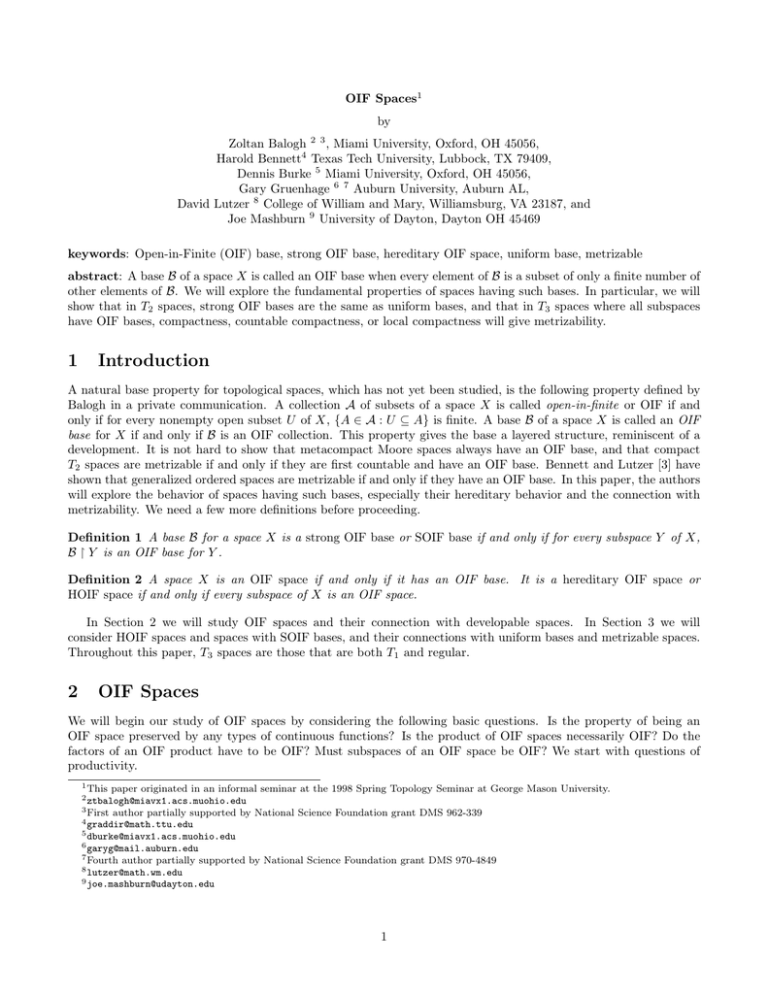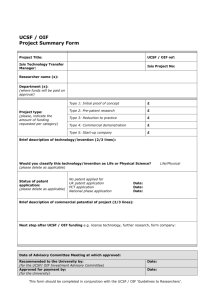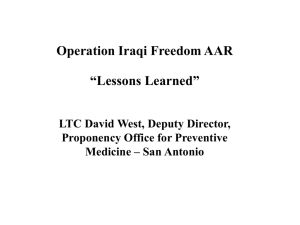OIF Spaces by Zoltan Balogh , Miami University, Oxford, OH 45056,
advertisement

OIF Spaces1
by
Zoltan Balogh 2 3 , Miami University, Oxford, OH 45056,
Harold Bennett4 Texas Tech University, Lubbock, TX 79409,
Dennis Burke 5 Miami University, Oxford, OH 45056,
Gary Gruenhage 6 7 Auburn University, Auburn AL,
David Lutzer 8 College of William and Mary, Williamsburg, VA 23187, and
Joe Mashburn 9 University of Dayton, Dayton OH 45469
keywords: Open-in-Finite (OIF) base, strong OIF base, hereditary OIF space, uniform base, metrizable
abstract: A base B of a space X is called an OIF base when every element of B is a subset of only a finite number of
other elements of B. We will explore the fundamental properties of spaces having such bases. In particular, we will
show that in T2 spaces, strong OIF bases are the same as uniform bases, and that in T3 spaces where all subspaces
have OIF bases, compactness, countable compactness, or local compactness will give metrizability.
1
Introduction
A natural base property for topological spaces, which has not yet been studied, is the following property defined by
Balogh in a private communication. A collection A of subsets of a space X is called open-in-finite or OIF if and
only if for every nonempty open subset U of X, {A ∈ A : U ⊆ A} is finite. A base B of a space X is called an OIF
base for X if and only if B is an OIF collection. This property gives the base a layered structure, reminiscent of a
development. It is not hard to show that metacompact Moore spaces always have an OIF base, and that compact
T2 spaces are metrizable if and only if they are first countable and have an OIF base. Bennett and Lutzer [3] have
shown that generalized ordered spaces are metrizable if and only if they have an OIF base. In this paper, the authors
will explore the behavior of spaces having such bases, especially their hereditary behavior and the connection with
metrizability. We need a few more definitions before proceeding.
Definition 1 A base B for a space X is a strong OIF base or SOIF base if and only if for every subspace Y of X,
B Y is an OIF base for Y .
Definition 2 A space X is an OIF space if and only if it has an OIF base. It is a hereditary OIF space or
HOIF space if and only if every subspace of X is an OIF space.
In Section 2 we will study OIF spaces and their connection with developable spaces. In Section 3 we will
consider HOIF spaces and spaces with SOIF bases, and their connections with uniform bases and metrizable spaces.
Throughout this paper, T3 spaces are those that are both T1 and regular.
2
OIF Spaces
We will begin our study of OIF spaces by considering the following basic questions. Is the property of being an
OIF space preserved by any types of continuous functions? Is the product of OIF spaces necessarily OIF? Do the
factors of an OIF product have to be OIF? Must subspaces of an OIF space be OIF? We start with questions of
productivity.
1 This
paper originated in an informal seminar at the 1998 Spring Topology Seminar at George Mason University.
2 ztbalogh@miavx1.acs.muohio.edu
3 First
author partially supported by National Science Foundation grant DMS 962-339
4 graddir@math.ttu.edu
5 dburke@miavx1.acs.muohio.edu
6 garyg@mail.auburn.edu
7 Fourth
author partially supported by National Science Foundation grant DMS 970-4849
8 lutzer@math.wm.edu
9 joe.mashburn@udayton.edu
1
Theorem 1 If Xα is an OIF space for every α ∈ κ, then
Q
α∈κ
Xα is an OIF space.
Proof 1 For every α ∈ κ let Bα be an OIF base for Xα . We may assume that for every α ∈ κ,
/ Bα . Let
T Xα ∈
F and G be finite subsets of κ. For every α ∈ F let Aα ∈ Bα and for every β ∈ G let Bβ ∈ Bβ . If α∈F πα−1 (Aα ) ⊆
T
T
−1
−1
β∈G πβ (Bβ ) then G ⊆ F and Aβ ⊆ Bβ for every β ∈ G. Thus
α∈F πα (Aα ) can be a subset of only a finite
number of other elements of the base.
Q
It follows that if Xα is discrete for every α ∈ κ then α∈κ Xα is an OIF space. In particular, 2κ is OIF for every
κ.
But the factors of an OIF product need not be OIF.
Lemma 1 If X is a space of weight κ and Y has an OIF base B which can be written as the union of κ many
pairwise disjoint subcollections Bα , α ∈ κ, each of which is a base for Y , then X × Y has an OIF base.
Proof 2 Let A = {Aα : α ∈ κ} be a base for X. Let C = {Aα × B : B ∈ Bα , α ∈ κ}. Obviously, C is a
base for X × Y . To see that C is OIF, let Aα × B ∈ C. The set of all C in B such that B ⊆ C is finite, so
F = {β ∈ κ : ∃C ∈ Bβ (B ⊆ C)} is finite. If Aα × B ⊆ Aβ × C, then β ∈ F . So {Aβ × C : Aα × B ⊆ Aβ × C} is
finite, and C is OIF.
Theorem 2 For every space X there is an OIF space Y such that X × Y is an OIF space.
Proof 3 Let κ = w(X). Let F be the set of finite subsets of κ having at least two elements. For every F ∈ F, let
δ(F ) = max(F
S ) and let γ(F ) = max(F \ {δ(F )}). For every α ∈ κ with 0 ∈ α, let Fα = {F ∈ F : δ(F ) = γ(F ) + α}.
Then F = {Fα : 0 ∈ α ∈ κ} and Fα ∩ Fβ = ∅ if α 6= β. Also, if F ∈ F and 0 ∈ α ∈ κ, then there is G ∈ Fα such
that F ⊆ G.
For every α ∈ κ with 0 ∈ α, let Bα be the set of all U ⊆ 2κ such that there is F ∈ Fα such that for every β ∈ κ,
πβ (U ) = 2 when β ∈
/ F and πβ (U ) = {0} or πβ (U ) = {1} when β ∈ F . Then B = ∪α∈κ Bα satisfies the conditions of
Lemma 1, and X × 2κ is OIF.
This also shows that every space X is a closed subspace of an OIF space having the same separation properties
as X. We will see that this can be strengthened to a closed Gδ subset.
Before going further into the study of subspaces of OIF spaces, we will use the Theorem 2 to settle the question of
whether OIF is preserved by any sort of continuous functions. Since discrete spaces are OIF spaces, something more
than continuity is needed. Ponomarev [5] has shown that any first countable space is an open continuous image of
a metric space, so the property of being an OIF space is not preserved by open continuous maps. Also, Bennett [1]
constructed a metacompact developable space X and a continuous open function with compact fibers mapping X
onto the Michael Line, which is not an OIF space. In fact, Theorem 2 shows that every space is the open perfect
image of an OIF space.
Corollary 1 Every space is the open perfect image of an OIF space.
Proof 4 Use the projection map π : X × 2κ → X, where κ = w(X).
One question that remains about products is the following
Question 1 If X × X is an OIF space, must X be an OIF space?
Returning to the question of subspaces of OIF spaces, we see that certain subsets of OIF spaces also behave well.
Theorem 3 If a space X has an OIF base B consisting of regular open sets and D is a dense subset of X, then D
is an OIF space.
Proof 5 If A, B ∈ B and A ∩ D ⊆ B ∩ D then A ⊆ B. Hence, B D is an OIF base for D.
Q
In particular, if Xα is discrete for every α ∈ κ and D is a dense subset of X = α∈κ Xα , then D is an OIF space.
Example 1 There is a countable T3 OIF space that is not first countable
2
Proof 6 Let X be a countable dense subset of 2ω1 . Then X is an OIF space by Theorem 1 and Theorem 3, and it
is not first countable since it is a dense subset of a T3 space that is not first countable.
Question 2 Is every dense subset of a T3 OIF space itself an OIF space?
If we are willing to drop regularity, the answer is no, as is shown by the following theorem and corollary. The
idea behind this example, and the next theorem is that in order to construct an OIF space with a subset that is not
an OIF space, we could attach a bad (that is, not OIF) space to a good (that is OIF) space by gluing every basis
element from the bad space to one from the good space. The OIF property of the good space keeps the new basis
elements from being subsets of too many of their companions. If this is done correctly, and in some cases the gluing
can be arbitrary, the result is an OIF space with some nice properties.
Theorem 4 Let X and Y be topological spaces satisfying the following properties.
(a) Y is T2 .
(b) X is dense in Y .
(c) For every open subset U of Y , |U ∩ (Y \ X)| ≥ w(Y ).
Then X is a dense subspace of a T2 OIF space.
Proof 7 Let κ = w(Y ) and let B be a base for Y with |B| = κ. There is {zα : α ∈ κ} ⊆ Y \ X and a collection
{Bα : α ∈ κ} of subsets of B such that
1. for every α ∈ κ, Bα is a neighborhood base for zα , and
T
2. if F is a nonempty finite subset of B, F =
6 ∅, and A ∈ B \ F, then there is α ∈ κ such that F ⊆ Bα and
A∈
/ Bα .
To see how these sets can be constructed, let F = {F ∈ [B]ω : ∩F =
6 ∅} and let G = {hF, Ai ∈ F × B : A ∈
/ F}.
Then |G| = κ so we can write G = {hFα , Aα i : α ∈ κ}. For every α ∈ κ let zα ∈ (∩Fα ) ∩ (Y \ X). By Property (c)
we can choose the zα ’s so that if α 6= β then zα 6= zβ . Now pick a neighborhood base Bα for zα so that Fα ⊆ Bα and
Aα ∈
/ Bα .
Set Z = X ∪ {zα : α ∈ κ}. For every B ∈ B let f (B) = {zα : B ∈ Bα } and S(B) = (B ∩ X) ∪ f (B). Give Z the
topology generated by the subbase S = {S(B) : B ∈ B}.
T
T
We will first show that X is dense in Z. Let F be a nonempty
T finite subset of B. If F = ∅, then B∈F f (B) = ∅,
otherwise there is α ∈Tκ with F ⊆ Bα which is impossible. If F =
6 ∅ then, by Property (2), there is α ∈ κ such that
F ⊆ Bα . Then zα ∈ B∈F f (B). Therefore, every basic open set generated by S intersects both X and Z \ X, and
X is dense in Z.
We next show that Z is T2 . Let p, q ∈ Z such that p 6= q. There are A, B ∈ B such that p ∈ A, q ∈ B, and
A ∩ B = ∅. If p ∈ X then p ∈ S(A) ⊆ A. If p ∈
/ X then there is α ∈ κ such that p = zα . There is Cp ∈ Bα such
that Cp ⊆ A. Then p ∈ S(Cp ) ⊆ A. Similarly, whether q is in X or not, there is a neighborhood Cq of q such that
q ∈ S(Cq ) ⊆ B. Thus Z is T2 .
T
T
Finally, we will show that Z is OIF. Let F and G be nonempty finite subsets of B such that F =
6 ∅ and G =
6 ∅.
If G * F, then there is C ∈ G \ F. By Property (2), there is α ∈ κ such that F ⊆ Bα and C ∈
/ Bα . Then
zα ∈ [∩A∈F S(A)] \ [∩B∈G S(B)]. Therefore ∩A∈F S(A) ⊆ ∩B∈G S(B) implies that G ⊆ F. Hence the base generated
by S is OIF.
Corollary 2 There is a T2 OIF space with a dense subset that is not an OIF space.
Proof 8 Let S represent the Sorgenfrey Line. Then S does not have an OIF base, since an OIF base of a first
countable space must be point-countable. But then the base would be countable since S is separable. (Alternatively
apply the metrization theorem of [3].) Now βS \ S is dense in βS, so S and βS satisfy the condition of Theorem 4.
In Theorem 5 this idea of gluing open sets together is used to show that every space is the closed subset of an
OIF space. But declaring the “good” space to be discrete, which is done to achieve the nice separation properties,
ensures that the “bad” space is not a dense subset of the resulting OIF space.
3
Theorem 5 Every space X is a closed subset of an OIF space O(X). If X is T1 , then it is a Gδ subset of O(X).
Furthermore, O(X) has the same separation properties as X, and if X has a point-countable base, so does O(X).
Proof 9 Let X be a space with a base A. Let F [A] be the set of all nonempty finite subsets of A and let Y =
{hp, Fi : p ∈ X and F ∈ F [A]}. For every U ∈ A let f (U ) = {hp, Fi ∈ Y : p ∈ U ∈ F} and let S(U ) = U ∪ f (U ).
Let O(X) = X ∪ Y with the topology generated by the subbase S = {S(U ) : U ∈ A} ∪ {{x} : x ∈ Y }. It is obvious
that X is a closed subset of O(X).
Assume that X is T1 . We may assume that X is infinite, since otherwise it is discrete and is already an OIF
space. Thus we may assume that every element of X is contained in an infinite number of elements of A. If not, we
can simply add complements of points. To show that X is Gδ , let Yn = {hp, Fi ∈ Y : |F| = n}. Each Yn is closed
in O(X). To prove this, we need only show that for every p ∈ X T
there is a neighborhood U of p in
T O(X) such that
U ∩ YT
G and |G| = n + 1. Thus p ∈ {S(B) : B ∈ G}
n = ∅. But there is a nonempty finite GT⊆ A such that p ∈
and [ {S(B) : B ∈ G}] ∩ Yn = ∅. Since X = n∈ω [O(X) \ Yn ], X is Gδ .
If hp, Fi ∈ Y , U ∈ A, and hp, Fi ∈ S(U ), then U ∈ F. But F is finite, so S is point finite on Y . Clearly, Y is
dense in O(X), so the base generated by S is an OIF base for Y .
We will next show that if X is T1 , so is O(X). We may again assume that every element of X is contained in an
infinite number of elements of A. Since Y itself is open in O(X), we need only consider elements of X to show that
a point is closed in O(X). Let p ∈ X. If q ∈ X \ {p} then there is U ∈ A such that q ∈ U and p ∈
/ U . So p ∈
/ S(U )
and q ∈ S(U ), proving that {p} is closed. Now let hp, Fi ∈ Y . If q ∈ X \ {p} then there is U ∈ A such that q ∈ U
and p ∈
/ U . So q ∈ S(U ) and hp, Fi ∈
/ S(U ). Since F is finite, we can find U ∈ A such that p ∈ U and U ∈
/ F. Then
p ∈ S(U ) and hp, Fi ∈
/ S(U ).
Notice that if U, V ∈ A and U ∩ V = ∅, then S(U ) ∩ S(V ) = ∅. To see how this leads to the result that the
separation properties of X are reflected in O(X), we will show that if X is T3 , so is O(X). The other separation
properties follow in a similar fashion. Assume that X is T3 . Let C be a closed subset of O(X). We only need to
show that the points of X \ C can be separated from C since the points of Y are isolated. Let p ∈ X \ C. There are
open subsets G and H
and G ∩ H = ∅. Let U ∈ A such
S of X such that p ∈ G, (C ∩ X) ⊆ H, S
S that p ∈ U ⊆ G and
let D ⊆ A such that D = H. Then p ∈ S(U
)
\
C,
C
∩
X
⊆
S(V
),
and
(S(U
)
\
C)
∩
V
∈D
V ∈D S(V ) = ∅. The
S
remaining points of C can now be added to V ∈B V to obtain the desired separation.
Finally, assume that A is point-countable. We have seen that S is point-finite on Y . It must now also be
point-countable on X. Thus S generates a point-countable base for O(X).
Example 2 There is a T3 OIF space with a point-countable base that is not quasi-developable.
Proof 10 If X is a T3 space with a point-countable base that is not quasi-developable, then O(X) is a T3 OIF space
with a point-countable base that is not quasi-developable. An example of such a space is the so-called “big bush”
constructed by Bennett in [2].
We end this section with an example of a countable space that is not an OIF space. It is trivial to find such a
space if no further conditions are required, since ω + ω with the topology {(ω + ω) \ α : α ∈ ω + ω} is not OIF. But
what if we wish the space to be T3 ? Obviously, the space cannot be first countable, for then it would be metric. In
fact, a point without a countable neighborhood base together with a bunch of isolated points is just what we need.
Example 3 There is a countable T3 space that is not an OIF space.
Proof 11 Let p ∈ βω \ ω. Let X = ω ∪ {p} with the topology inherited from βω. If B is an OIF collection of open
subsets of X, then B must be countable, since each n ∈ ω can be in only a finite number of elements of B. Thus B
cannot be a base for X.
3
HOIF spaces and spaces with SOIF bases
We begin this section with the strongest of the base properties under consideration: that of having a strong OIF base,
or SOIF base. As the next theorem shows, every uniform base is an SOIF base. As we shall see, the implication
usually goes the other direction, but the space does have to be Hausdorff. This is not true for T1 spaces, or for spaces
with the weaker property of being an HOIF space. Recall
T that a base B of a space X is a uniform base if and only if
for every p ∈ X if A is an infinite subset of B and p ∈ A, then A is a neighborhood base for p. In a regular space,
having a uniform base is equivalent to being a metacompact Moore space.
4
Theorem 6 If B is a uniform base for a space X, then B is an SOIF base.
Proof 12 We need only show that every uniform base is OIF, since the restriction of a uniform base to a subspace
is uniform. Let A be an element of B and assume that there is an infinite subset C of B such that A ⊆ C for every
C ∈ C. We may assume that no element of C is equal to A. Pick any p ∈ A. Now p ∈ C for every C ∈ C, but C is
not a neighborhood base for p because no element of C is a subset of A. This contradicts the assumption that B is
uniform, so B must be OIF.
Theorem 7 If B is an SOIF base for a T2 space X, then B is uniform
The idea behind the proof of this theorem is to try to make sure that the basic open sets that witness the fact
that a base is not uniform at a point p have differences away from p. We can use the Hausdorff property to force
the differences in these sets to occur outside a neighborhood of p. That neighborhood can then be used to define a
subspace in which p is isolated, and is contained in the infinite number of sets whose differences have been preserved
in the subspace.
Proof 13 Let B be a base for X that is not uniform. We will show that B cannot be an SOIF base. Since B is not
uniform, there exist p ∈ X, U ⊆ B, and an infinite subset A of B such that p ∈ U and for every A ∈ A, p ∈ A and
A \ U 6= ∅. If {A \ U : A ∈ A} is infinite, set Y = (X \ U ) ∪ {p}. Then A Y is infinite and U ∩ Y = {p} ⊆ A ∩ Y
for all A ∈ A. Hence B Y is not OIF.
Assume that {A \ U : A ∈ A} is finite. There is an infinite subset C of A and a subset R of X such that B \ U = R
for every B ∈ C. Let q ∈ R and let V be a neighborhood of p such that q ∈
/ V and V ⊆ U . Note that X \ V intersects
an infinite number of elements of A. If {A ∩ (X \ V ) : A ∈ A} is infinite, set Y = (X \ V ) ∪ {p}. Then C Y is
infinite and V ∩ Y = {p} ⊆ A ∩ Y for every A ∈ C. Thus B Y is not OIF. If {A ∩ (X \ V ) : A ∈ A} is finite, then
there is an infinite D ⊆ C and an open subset G of X such that A ∩ (X \ V ) = G for every A ∈ D. But then G ⊆ A
for all A ∈ D, and B is not OIF.
Note that we actually proved the following result. Let B be a base for a T2 space X. If B C is OIF for every
closed subset C of X, then B is uniform.
Question 3 If B Y is an OIF base for Y for every closed subset Y of a space X, is B an SOIF base for X?
The answer to this question is yes in T2 spaces by Theorems 6 and 7.
That SOIF bases need not be uniform when the space is no longer T2 is seen by the following example.
Example 4 There is a first countable T1 space with an SOIF base that is not uniform.
Proof 14 The set ω with the cofinite topology is a first countable T1 space. The usual base of all cofinite sets is an
SOIF base, but is not uniform, since the set of all cofinite sets containing both 0 and 1 is not a neighborhood base
for either point.
The previous example does have a uniform base. For every m, n ∈ ω with m ≤ n, let B(m, n) = {m} ∪ (ω \ n).
Then {B(m, n) : m, n ∈ ω and m < n} is a uniform base. The space ω1 with the cofinite topology has an SOIF base,
but does not have a uniform base.
Question 4 Is there a first countable T1 space with an SOIF base that does not have a uniform base?
We know that T2 SOIF spaces must be first countable, since the SOIF base is uniform. What if we weaken
the base condition to that of being an HOIF space? That is, every subset is an OIF space, but not necessarily
by restricting the given base to the subspace. The following example showing that such spaces need not be first
countable again uses the idea of gluing bases elements that was used in the previous section.
Example 5 There is a T3 HOIF space with exactly one nonisolated point that is not first countable.
5
Proof 15 Let F be an uncountable free filter on ω and let W = ω + 1 with the topology generated by the base
A = {{n} : n ∈ ω} ∪ {F ∪ {ω} : F ∈ F}. The space O(W ) as constructed in Theorem 5 is a T3 OIF space. Let B be
the OIF base for O(W ) as defined in that theorem. Set Y = O(W ) \ (ω + 1) and X = O(W ) \ ω. Now Y is dense
in X and B is point-finite on Y , so C = B X is an OIF base for X. Let Z be a subspace of X. If Z is discrete, it
has an OIF base. If Z is not discrete, then ω ∈ Z and ω is a limit point of Z ∩ Y . But C is point-finite on Z ∩ Y ,
so C Z is an OIF base for Z. Hence X is an HOIF space.
We next show that ω does not have a countable neighborhood base. A typical subbasic neighborhood of ω in O(W )
is F ∪ ω ∪ {hn, Gi : n ∈
TF ∈ G}, where G is a finite subset of F. Therefore, a typical basic neighborhood of ω in X
is {ω} ∪ {hn, Gi : n ∈ H and H ⊆ G}, where H is a nonempty
T finite subset of F. For every n ∈ ω, let Hn be a
nonempty finite subset
of
F,
and
let
H
=
{ω}
∪
{hn,
Gi
:
n
∈
Hn and Hn ⊆ G}. Since F is an uncountable filter,
n
S
T
there is F ∈ F \ n∈ω Hn . Let n ∈ ω with n ∈ Hn . Then hn, Hn i ∈ Hn , but hn, Hn i is not an element of
{ω} ∪ {hm, Gi : m ∈ F ∈ G}. Thus {Hn : n ∈ ω} is not a neighborhood base for ω.
The remainder of the paper is devoted to the study of the connection between HOIF spaces and metrizability.
We will first see that when a space passes on the property of having an OIF base to each of its subspaces, it also
passes on the properties of being Lindelöf or countably compact. Using this fact, we will show that in the presence
of several types of compactness conditions, HOIF spaces are metrizable.
Lemma 2 Let D be a relatively discrete subset of a T1 Lindelöf space X. If D has an OIF base, then D is countable.
If X is T3 then D is a separable metric space.
Proof 16 Let B be an OIF base for D. For every n ∈ ω, let Dn = {p ∈ D : ord(p, B) ≤ n}. Because each {p} is
open in D and B is OIF, we know that D = ∪∞
n=1 Dn . But each Dn is closed in D, so it is Lindelöf and therefore
countable.
S Now assume that X is T3 . For every p ∈ D, {p} is open in D, so
S {B ∈ B : p ∈ B} is finite. Since D is countable,
p∈D {B ∈ B : p ∈ B}. Thus D is T3 and second
p∈D {B ∈ B : p ∈ B} is countable. But D is dense in D, so B =
countable, and must be a separable metric space.
Note that a slight modification of the second paragraph of the above proof actually shows that every T3 separable
first countable OIF space is metrizable.
Theorem 8 If X is a T3 Lindelöf HOIF space then X is hereditarily Lindelöf.
Proof 17 If X is not hereditarily Lindelöf there is a subset Z = {pα : α ∈ ω1 } of X such that {pα : α ≤ β} is open
in Z for every β ∈ ω1 . We will inductively define a subset of Z and show that it is a countable dense subset of Z.
Set ϕ(0) = 0. Let γ ∈ ω1 and assume that ϕ(α) ∈ ω1 for every α ∈ γ. If Z ⊆ ClX {pϕ(α) : α ∈ γ} = Cγ then set
ϕ(γ) = 0. If Z * Cγ , let ϕ(γ) = min{α ∈ ω1 : pα ∈
/ Cγ }. Let A = {α ∈ ω1 : α = 0 or ϕ(α) > 0}. Note that if
α, β ∈ A with α < β, then ϕ(α) < ϕ(β). Also, for every α ∈ A, α ≤ ϕ(α).
For every β ∈ A there is a neighborhood Uβ of pϕ(β) such that Uβ ∩ Cβ = ∅. Then Uβ ∩ {pα : α ≤ ϕ(β)} ∩ {pϕ(α) :
α ∈ A} = {pϕ(β) }. But Uβ ∩ {pα : α ≤ ϕ(β)} is open in Z, so D = {pϕ(α) : α ∈ A} is relatively discrete. Also, we
see from the construction of A that Z ⊆ ClX (D). Since ClX (D) has an OIF base, D is countable and ClX (D) is a
separable metric space by Lemma 2. Therefore Z is Lindelöf, in contradiction to our assumption.
By replacing Lindelöf with countably compact, we can obtain similar results.
Lemma 3 Let D be a relatively discrete subset of a T1 countably compact space X. If K = D has an OIF base, then
D is countable. If X is T3 then K is a separable metric space.
The proof is the same as that of Lemma 2, with the Dn sets being countably compact and therefore finite.
Theorem 9 If X is a countably compact T3 HOIF space, then X is hereditarily Lindelöf.
The proof of Theorem 9 follows from Lemma 3 exactly as Theorem 8 followed from Lemma 2.
We can also replace Lindelöf by ω1 -compact and get similar results. In particular, every T3 separable collectionwise
Hausdorff space is hereditarily Lindelöf.
Note that in Lemma 2 through Theorem 9, we are really only using the fact that every closed subset of the given
space has an OIF base.
6
Question 5 If every closed subset of a space X has an OIF base, is X an HOIF space?
The answer is yes for T3 spaces if dense subsets of T3 OIF spaces have OIF bases.
Finally, we can use the hereditary Lindelöf properties of Theorems 8 and 9 to get the following metrization
theorems.
Corollary 3 If X is an HOIF space, then it is metrizable if it satisfies any of the following conditions.
1. X is compact T2 .
2. X is countably compact T3 .
3. X is locally compact T2 .
Proof 18 Assume that X is compact T2 or countably compact T3 . Then X is hereditarily Lindelöf by Theorem 9
and so is first countable. But any OIF base of a first countable space must be point-countable. Since X is compact
or countably compact and has a point-countable base, it is metrizable.
Assume that X is locally compact T2 . Let U be an open subset of X whose closure C is compact. Then C is
metrizable and hence first countable. Since every element of X is contained in such an open set, X is first countable.
Thus the OIF base for X is point-countable, and X is metrizable.
Note that we cannot weaken HOIF to OIF in Corollary 3. For a Tychonoff cube of uncountable weight is a
compact T2 OIF space by Theorem 1.
Corollary 4 If a paracompact p-space is an HOIF space, then it is metrizable.
Proof 19 Let X be a T3 HOIF p-space. If Y is a compact subspace of X then Y is a T3 compact HOIF space and
is therefore metrizable. It follows that every point in X is Gδ , and X must be first countable. But an OIF base in
a first countable space is point-countable, and it is known that paracompact p-spaces with a point-countable base are
metrizable.
Question 6 Do HOIF p-spaces have to be Moore spaces?
Added in proof: After this paper was accepted for publication, the authors discovered related results in [4], to
which the reader is referred.
References
[1] Harold Bennett, On Arhangel’skii’s class MOBI, Proc. Amer. Math. Soc., 26 (1970), 178–180.
[2] Harold Bennett, A note on point-countability in linearly ordered spaces, Proc. Amer. Math. Soc., 28 (1971),
598–606.
[3] Harold Bennett and David Lutzer, Ordered Spaces with Special Bases, Fund. Math., 158 (1998), 289–299.
[4] V. I. Malykhin, On Noetherian Spaces, [Seminar on general topology, 51–59, Moskov. Gos. Univ., Moscow, 1981;
MR 83f:54023] AMS Translations, Series 2, Vol. 134 (1987), 83–91.
[5] V. Ponomarev, Axioms of countability and continuous mappings, Bull. Polon. Sci. Ser. Math. Astr. Phys., 8
(1960), 127–133.
7







